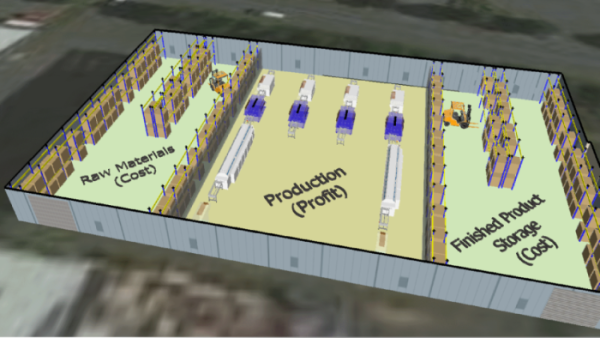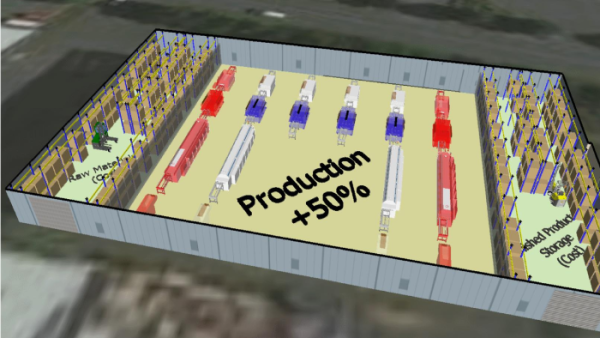- FMA
- The Fabricator
- FABTECH
- Canadian Metalworking
Categories
- Additive Manufacturing
- Aluminum Welding
- Arc Welding
- Assembly and Joining
- Automation and Robotics
- Bending and Forming
- Consumables
- Cutting and Weld Prep
- Electric Vehicles
- En Español
- Finishing
- Hydroforming
- Laser Cutting
- Laser Welding
- Machining
- Manufacturing Software
- Materials Handling
- Metals/Materials
- Oxyfuel Cutting
- Plasma Cutting
- Power Tools
- Punching and Other Holemaking
- Roll Forming
- Safety
- Sawing
- Shearing
- Shop Management
- Testing and Measuring
- Tube and Pipe Fabrication
- Tube and Pipe Production
- Waterjet Cutting
Industry Directory
Webcasts
Podcasts
FAB 40
Advertise
Subscribe
Account Login
Search
Rethinking material handling for tube, pipe, profile
A sideloading, multidirectional fork truck can provide three distinct benefits
- By Eric Lundin
- January 4, 2022
- Article
- Materials Handling

A conventional forklift is ideal for compact loads, but for handing long-length materials such as tube, pipe, and profile, a multidirectional sideloading lift truck can improve safety, optimize storage density, and even streamline manufacturing operations. Images: Combilift
Wherever materials in large quantities are stored, traditional operations rely on conventional equipment and a conventional layout. Often this means using a forklift to transport materials, and for many applications, a forklift is ideal. For moving pallets, crates, and other short loads, a forklift has the necessary dexterity. When aisles are just a few feet wide, most of the floor space is dedicated to inventory, and the storage density is optimal for the operation.
Some companies that deal in long loads—those that exceed 10 ft. or so, like tube, pipe, and profiles—still use conventional methods. These companies, whether producers, service centers, or fabricators, develop processes that work with traditional equipment, even though more efficient material handling trucks are available and more streamlined operations are possible.
Long Loads, Wide Aisles
A standard approach is straightforward: Set aside enough storage space for a healthy inventory level, invest in a few forklifts, and get to work. As the business grows, the company might build an addition and invest in more forklifts, but often a complete rethinking of storage, material handling, and processes is not in the cards.
Long Loads Held High. Using a forklift to transport a load by traditional means often requires elevating the load to avoid a multitude of obstacles—personnel, equipment, inventory, and even elements of the warehouse itself. This approach runs contrary to general OSHA guidance that emphasizes keeping loads as low as possible. If the load is held high and it isn’t well balanced, or if it shifts, the forklift can tip.
Even when the load can be lowered, the load’s orientation—perpendicular to the direction of travel—means that the driver has to assess a wide field of vision, constantly scanning left, right, and straight ahead as he navigates the facility.
Wide Open Spaces. Wide open spaces are good for grazing cattle and children at play, but they are the antithesis of good manufacturing operations. Picking material up, dropping it off, and swinging through 90-degree turns are actions that take up quite a bit of space when using a conventional forklift to haul long loads.
Space Utilization. Finally, every square foot of empty floor space dedicated to transportation is one less square foot of floor space dedicated to something useful or productive, such as more inventory or equipment. As a company grows, a common reaction is to add to the facility’s footprint. This means either putting up an additional building or adding onto an existing one. These are costly, time-consuming projects which do nothing to reduce or eliminate the underlying inefficiency.
A New Perspective in Material Handling
On the surface, a sideloading lift truck’s main advantage is that it doesn’t swing the load 90 degrees after retrieving it. In other words, when a tube, pipe, or profile is in storage, its long axis is parallel to the aisle’s length, and a sideloader transports it in the same orientation. However, it doesn’t end there. A multidirectional sideloader can switch direction, literally 90 degrees, when the driver pivots the wheels. It’s similar to having zero-turn radius, but it doesn’t even turn; it simply changes direction. If the cab is facing north, the operator can drive a multidirectional lift truck along the north-south axis, come to a stop, switch the direction of the wheels 90 degrees, and drive along the east-west axis.

For manufacturers that store raw material and finished product indoors, a low-density storage system can use up quite a bit of valuable floor space.
Imagine a parking space that is about 6 in. longer than your car. If you could pivot the wheels 90 degrees, you could slip into that parking space and you’d have 3 in. of clearance at each end. This is the versatility of a sideloading lift truck.
It gets better. For operations that rely on moving materials often throughout the day, the lift truck’s cab has a seat for the driver, but for operations that move materials less frequently, the company can specify a stand-up cab. This design, which eliminates the driver’s seat, reduces the profile of the fork truck. This allows it to work in even narrower aisles than a sideloader with a conventional cab and a seat.
A New Perspective in Warehouse Layout
One sideloading, multidirectional lift truck manufacturer, Combilift, offers more than lift trucks; it offers warehouse layout consultation at no charge. Using each customer’s longest products as a point of reference, along with drawings that detail the current storage space layout, Combilift’s layout personnel devise a tailored plan that optimizes the site’s storage efficiency.
“Since we established the company, it has been our byword that rather than just supplying lifts trucks, we see ourselves as providers of complete warehouse solutions, and our layout service has been a key element of this,” said Managing Director Martin McVicar. “The combination of the four-way design, with their ability to travel sideways with long loads and negotiate tight confines, together with a radical rethink of stacking and storing methods, can exploit the full potential of the available space.”
The result is usually far more than an incremental increase in space utilization, according to McVicar.
“We find that the space recaptured can be in excess of 30% when handling palletized goods with our Aisle Master articulated trucks and up to 100% when handling long loads with the Combilift range,” McVicar said. That might be hard to believe, but according to McVicar, it’s not hard to see.
“The appearance of the finished layout is very clear and concise and can instantly convey the level of improvement,” he said.
The process sounds straightforward, but because it’s a matter of analyzing volumes in three dimensions, it’s more complex than merely creating narrowing aisles.
“Whatever size of company, from small family operations to large global concerns, providing data is crucial as the first step,” McVicar said. “In addition to detailed information on the size of loads handled—length, width, weight, and so on—we need dimensions of the area that is to be used for storage, the upper and lower roof height, eave height, the locations of entrance and exit points and loading bays, plus information on any outside areas that may also be used. We also make use of technology such as Google Maps, which is a great way of clarifying the information we have been given, because sometimes even the most carefully gathered data is not 100% correct.”

The benefits of converting to a high-density storage strategy can include not only a larger production area, but potentially a reorganized production area.
The company’s engineers don’t just map the new layout but simulate its use.
“Using our design software and 3D simulations, the designers then create layout diagrams that provide the best possible storage density,” he said. For customers that haven’t yet decided on a specific purchase, the software provides recommendations on which lift truck models correspond to the layouts.
A Path to Improved Productivity
Streamlining a storage system and the material handling process is likely to cut the amount of time spent moving material, freeing up some human capital to spend time on more productive undertakings. Also, releasing a substantial amount of floor space provides an opportunity to dedicate more square footage to production, but it could do more than that. It can be a chance to rethink an entire fabricating operation.
Many high-volume/low-mix manufacturers transitioned from batch production to one-piece flow long ago. While this isn’t necessarily easy or practical in a low-volume/high-mix environment, fabricators might find that they can use the concept of flow to wring additional efficiencies out of their operations if they have a chance to reorganize the manufacturing floor. Freeing up some space could be the key to rethinking how material moves through the facility.
This also presents an opportunity to review the company’s entire material handling strategy.
“Many companies still use one type of forklift outdoors, another indoors, and possibly even another for moving specific products,” McVicar said. Aligning them simplifies all of the activities that support a company’s material handling efforts. “Using one brand improves utilization across the board and saves on the capital investment, maintenance, insurance, and training costs.”
About the Author

Eric Lundin
2135 Point Blvd
Elgin, IL 60123
815-227-8262
Eric Lundin worked on The Tube & Pipe Journal from 2000 to 2022.
About the Publication
Related Companies
subscribe now

The Tube and Pipe Journal became the first magazine dedicated to serving the metal tube and pipe industry in 1990. Today, it remains the only North American publication devoted to this industry, and it has become the most trusted source of information for tube and pipe professionals.
start your free subscription- Stay connected from anywhere

Easily access valuable industry resources now with full access to the digital edition of The Fabricator.

Easily access valuable industry resources now with full access to the digital edition of The Welder.

Easily access valuable industry resources now with full access to the digital edition of The Tube and Pipe Journal.
- Podcasting
- Podcast:
- The Fabricator Podcast
- Published:
- 04/16/2024
- Running Time:
- 63:29
In this episode of The Fabricator Podcast, Caleb Chamberlain, co-founder and CEO of OSH Cut, discusses his company’s...
- Trending Articles
Team Industries names director of advanced technology and manufacturing

3D laser tube cutting system available in 3, 4, or 5 kW

Corrosion-inhibiting coating can be peeled off after use

Zekelman Industries to invest $120 million in Arkansas expansion

Brushless copper tubing cutter adjusts to ODs up to 2-1/8 in.

- Industry Events
16th Annual Safety Conference
- April 30 - May 1, 2024
- Elgin,
Pipe and Tube Conference
- May 21 - 22, 2024
- Omaha, NE
World-Class Roll Forming Workshop
- June 5 - 6, 2024
- Louisville, KY
Advanced Laser Application Workshop
- June 25 - 27, 2024
- Novi, MI


























